




 |
 |
 |
 |
 |
DEVELOPMENT |
ONLINE
PROJECTS |
|||||
| Hot air Tools : a short guide to important points | |
| Hot Air Tools get VERY HOT so be aware of exactly how and where you place them. | |
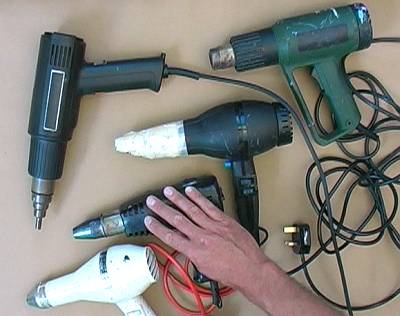 |
Hot air tools offer great possibilities and potentials for creative and artistic encaustic art work. The market place is full of DIY shops where electric paint strippers are available and hair dryers can be obtained from any good hair salon. There are many qualities and factors involved in use of these tools and no tool types will operate in exactly the same manner. Investigate.... |
| Click HOT
AIR SOURCES to
open up to date link page in a new
window. Alternatively search the web for [Hot Air Paint Stripper] or [Heat Gun] or [Hot Air Gun] etc. |
|
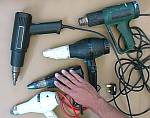 |
The main factors to consider are: |
| GENERAL OVERVIEW: Heating wax colours with hot air enables all sorts of approaches to be explored. Hot Air Guns or Hairdryers are the most common types available & offer very different possibilities due to the variety of air flow strengths and the temperature spans of these tools. They are not toys & can become very hot, remaining so for several minutes after use, so always treat these items with utmost awareness of safety and place them well out of harms way when not in use. They can blow or heat the wax for pan & tilt of the substrate, apply blowing heat for working on canvas or boards, be used for fusing of wax already applied by brush or other means. The list goes on, but first read this page to understand what is important in selecting these tools. | |
| Ideal properties for a hot air gun to enable control & flexibility. | |
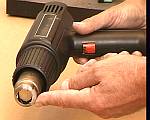 |
The full open venting end of the hot air gun gives the fullest & softest blast available for the unit. For general heating of a surface this is the normal way to use the tool. It gets very hot, so never let it touch or contact anything until it is once again cool. Often the opening inside the heat tube has a bluffing piece inside to force the air into the internal heating elements before gushing out. |
 |
Restrictors are available as snap on nozzles of various shapes. The most commonly useful shapes are cones which come in various diameters. These reduce the size of the outflow orifice, thus forcing the air to move faster & in a tighter space. They have the effect of creating a more focused blast that is easier to use if you are actually blowing the wax colours around & also limits the heating to a smaller work zone area. Over-restriction can cause the units to overheat, so use nozzles made by the same manufacturer & for the same model of tool you are using. |
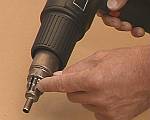 |
Smaller reduction nozzles that restrict the air flow dramatically, like this one shown here, will have a vent orifice (where the finger is pointing). This allows some of the hot air to escape into the atmosphere & averts the overheating that might happen if the hot air gun can not clear the heat it is generating fast enough. To prevent unintended melting, ensure that the nozzle vent (if present) is not directing heated air onto your working surface or the wax. Any good hot air gun should have a safety mechanism that cuts out if it overheats - salon quality hair dryers usually have these too. |
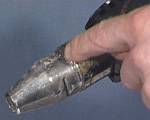 |
This nozzle is about the most common size of reduction and does not have any venting. The motor & hot air gun are designed for this condensing of the heat into a faster blast. The nozzle is just a push on fit, so make sure that you are using one from the correct manufacturer & that it is tightly attached before you start working. |
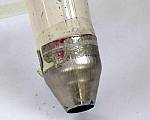 |
This is an example of a hair dryer fitted with a reduction nozzle from a hot air gun. The hair dryer has a safety cut out, so if it overheats internally then it simply cuts out until it has cooled sufficient to operate safely. Remember when fitting a nozzle that reduces the ability of the tool to expel the heat it is generating, that you MUST only limit the nozzle to the manufacturers recommendations. And use tools with that internal safety cut-out switch to be sure that you do not burn the heating elements out or cause any other heat dangers. |
 |
Many hot air guns & pretty much all hairdryers have a set of switches to control the air flow speed & the heat generation setting. However, the better hot air guns will have the ability to select any temperature within the hottest & coldest range of the tool. This is usually managed by use of a rotary dial, like the one shown here, although some are sited on the side of the hot air gun, but are usually then less accurate. |
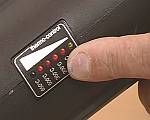 |
Some of the hot air guns will have an added visual facility that displays the temperature currently operating in the unit. This is usually a strip of lights that glow red as the unit heats up. This is a useful aid but not vital. |
 |
The hot air gun switches are often in 3 stages : - OFF |
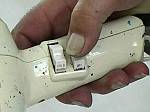 |
Hair dryers are usually operated by 2 sets of rocker switches, One operates the OFF : ON LOW SPEED: ON HIGH SPEED set of options whilst the other operates the temperature modes often being COLD : WARM : HOT |
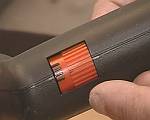 |
The ideal hot air guns also have an option to control the air flow output of the unit so that a slow soft air flow or a faster vigorous blast can be set. This one has a rotary dial in the handle, set here at fastest flow (IIII) but can rotate back down to (I). The best units have electronic controls that compensate for the decreased or increased flow, thus maintaining the correct similar temperature. |
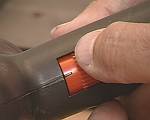 |
Here, set at (I) the hot air gun is just wafting out a gentle soft flow of air, ideal for melting without blowing or disturbing the wax too much. These are luxury facilities in the tool & although they are well worth having, there is a great deal that can easily be accomplished without them & just as successfully too. |
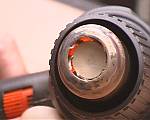 |
Remember, the internal & metal parts of the hot air gun get extremely hot! You can see the glowing element when it is switched on & this is only a couple of millimeters the other side of the metal tube out of which the air blows. So do be most careful, especially if other people are working in the same area as you. |
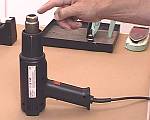 |
Some hot air guns are designed to stand on end, like the one shown here. This is a safe way to place them after use, provided that you do not lean over them inadvertently. BEWARE, BE AWARE! |
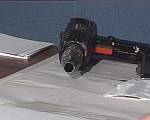 |
Hot air guns that must be laid down after use should not be placed in contact with combustible materials. The nozzles, if required to be removed, should only be handled when the unit is cold. One way to speed up the cooling is to run the gun on the cold setting with maximum air flow. This flushes out the heat and soon cools down the barrel on which the nozzle is pushed. |
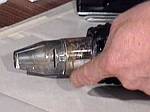 |
An airspace of a couple of centimeters is normally sufficient to prevent any heat damage. Ideally use a heat proof surface under the hot air gun. Enjoy the possibilities these fantastic & accessible tools offer for encaustic art approaches. Each tool is different to use! |
|